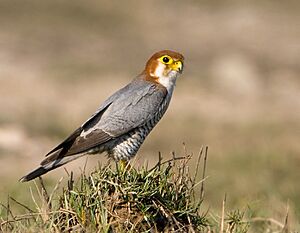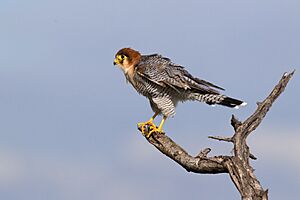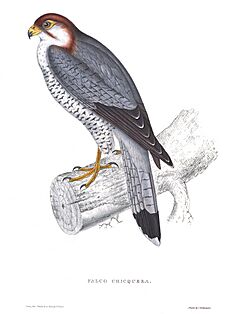Red-necked falcon facts for kids
Quick facts for kids Red-necked falcon |
|
|---|---|
 |
|
| Falco chicquera chicquera (India) | |
 |
|
| Falco chicquera ruficollis (Etosha, Namibia) | |
| Conservation status | |
| Scientific classification | |
| Genus: |
Falco
|
| Species: |
chicquera
|
| Subspecies | |
|
See text |
|
 |
|
| Synonyms | |
|
|
The red-necked falcon (Falco chicquera) is a type of bird of prey that belongs to the falcon family. These birds live in two separate areas: one group is found in India, and the other lives in Africa.
This medium-sized falcon has bluish-grey wings and an upper body. It has a special chestnut-red cap on its head, with short lines that look like straps passing through its eyes. Its wing feathers are black at the tips, and it has a single black band at the end of its tail.
The red-necked falcon found in India is called Falco chicquera chicquera. It is also known as the red-headed merlin or red-headed falcon. This bird mainly lives in the open plains of India. The other group, Falco chicquera ruficollis, lives in Africa. Some experts think this African bird is a completely different species, called the rufous-necked falcon (Falco ruficollis). This is because it lives far away from the Indian group and has slightly different markings.
The African red-necked falcon looks very similar to the Indian one. However, it has dark stripes on its upper body, a reddish-brown band on its chest, and black stripes near its eyes and mouth. Like most falcons, the female birds are larger than the males. In India, people who train falcons call the female a turumti and the male a chatwa. These falcons often hunt in pairs, usually early in the morning or late in the evening. They catch small birds, bats, and squirrels.
Contents
What Does the Red-Necked Falcon Look Like?
| Measurements | |||
|---|---|---|---|
| Nominate | |||
| Culmen | 19–24 mm (0.75–0.94 in) | ||
| 25 mm (0.98 in) | |||
| Wing | 190–207 mm (7.5–8.1 in) | ||
| 220–232 mm (8.7–9.1 in) | |||
| Tail | 124–137 mm (4.9–5.4 in) | ||
| 148–156 mm (5.8–6.1 in) | |||
| Tarsus | 35–40 mm (1.4–1.6 in) | ||
| 38–41 mm (1.5–1.6 in) | |||
| ruficollis | |||
| Wing | 227–240 mm (8.9–9.4 in) | ||
| Weight | 193–239.4 g (6.8–8.4 oz) | ||
The red-necked falcon is a medium-sized bird with long wings. It has a bright reddish-brown crown (the top of its head) and nape (the back of its neck). It is usually about 30 to 36 centimeters (12 to 14 inches) long. Its wings can spread out to about 85 centimeters (33 inches).
Its wings and upper body are bluish-grey. Its tail has thin stripes and a wide black band near the tip, which is white. When the bird is resting, its wingtip does not reach the end of its tail. The second and third feathers on its wings are the longest.
The bird's legs, the waxy part above its beak (called the cere), and the skin around its eyes are yellow. The tip of its beak is black, while the bottom part is greenish-yellow. The red-necked falcon makes a loud, sharp sound that sounds like ki-ki-ki-ki. Male and female falcons look similar, but the males are smaller. Young birds have a duller color on their upper bodies and less clear stripes.
Different Types of Red-Necked Falcons (Subspecies)
There are two main types, or subspecies, of the red-necked falcon:
African Red-Necked Falcon
The adult African subspecies is called Falco chicquera ruficollis. It was first described by William Swainson in 1837. This bird has a white face, except for black marks that look like a mustache. Its upper body is light grey, with black feathers on its wings and a wide black band on its tail. Its belly and the underside of its wings are white with dark stripes. It also has a reddish-brown band on its front neck, which the Indian type does not have.
Male African falcons in West Africa usually weigh between 139 and 178 grams. Females are heavier, weighing between 190 and 305 grams.
Asian Red-Necked Falcon
The Asian nominate subspecies is called Falco chicquera chicquera. This type has reddish-brown stripes that look like a mustache. It does not have the reddish-brown chest band seen in the African type. It also has fewer stripes on its body compared to the African form.
Where Do Red-Necked Falcons Live?
In Africa, the red-necked falcon lives in semi-desert areas, savannahs, and other dry, open places that have some trees. They also live near rivers. They often perch and build their nests in the tops of tall palm trees. These birds usually stay in one place, but they might move around if the weather changes.
In India, these falcons live in open areas. They are not found in thick forests or high mountains. The Indian subspecies was once thought to live as far west as Iran, but there have been no sightings there since 1970. They have also been seen in northern Sri Lanka during the winter.
How Do Red-Necked Falcons Behave?
Red-necked falcons usually hunt in pairs. They often hunt early in the morning or late in the evening. One falcon might fly low to scare small birds out of hiding, while the other flies higher up and catches the prey as it flies out. They fly very fast and quickly.
These falcons prefer to hunt birds that live in open areas. They have been seen hunting many different types of birds, such as sparrows, wagtails, starlings, doves, and larks. They also eat mice, lizards, and large insects. In one study, adult falcons mainly ate small birds and bats. Sometimes, they might even steal food from other medium-sized birds of prey. They might also hide their prey and eat it later.
Red-necked falcons drink water in the afternoons if it is available. This has been seen in both India and Africa, where they sometimes visit waterholes.
Red-Necked Falcon Reproduction and Life Cycle
The breeding season for red-necked falcons in India is from January to March. In Zambia, it starts in August. Sometimes, the female falcon will feed the male during courtship, which is a bit unusual.
These falcons often use old nests that other birds, like corvids (crows and jays), have left behind. They might also build their own nests in the fork of a tall tree or in the top of a palm tree. In Africa, they have been known to use nests of pied crows or African fish eagles. In India, nests are often found in large mango trees and are hidden by leaves.
The falcons protect their nest area very well and will chase away crows and kites. They have even been known to nest in trees in busy human areas. The female lays two to four eggs. She is the only one who sits on the eggs to keep them warm, starting after the last egg is laid. The eggs hatch after about 32 to 34 days. The newly hatched chicks are covered in white fuzz. The female stays with the chicks for about a week. The male brings food, which the female tears into pieces and feeds to the chicks. The young birds are ready to fly after about 35 to 37 days in Africa, and up to 48 days in India.
Red-Necked Falcons in Falconry
The turumti (female red-necked falcon) was a favorite bird for people who practiced falconry in India. Falconers would often use them to hunt the Indian roller, a bird known for its tricky flying moves, which was entertaining to watch. These falcons were caught using a special trap called a bal-chatri. This trap worked well because red-necked falcons not only catch prey in the air but also chase it on the ground, which could get them tangled in the trap's ropes. The name Turumta was also used in Iran for the merlin, another type of falcon.
Images for kids





